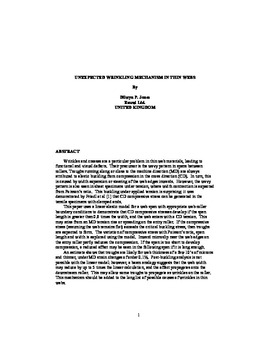| dc.contributor.author | Jones, Dilwyn P. | |
| dc.contributor.other | International Conference on Web Handling (2019) | |
| dc.date.accessioned | 2019-06-04T16:16:32Z | |
| dc.date.available | 2019-06-04T16:16:32Z | |
| dc.date.issued | 2019-06 | |
| dc.identifier | oksd_icwh_2019_jones | |
| dc.identifier.citation | Jones, D. P. (2019, June). Unexpected wrinkling mechanism in thin webs. Paper presented at the Fifteenth International Conference on Web Handling (IWEB), Stillwater, OK. | |
| dc.identifier.uri | https://hdl.handle.net/11244/320250 | |
| dc.description.abstract | Wrinkles and creases are a particular problem in thin web materials, leading to functional and visual defects. Their precursor is the wavy pattern in spans between rollers. Troughs running along or close to the machine direction (MD) are always attributed to elastic buckling from compression in the cross direction (CD). In turn, this is caused by width expansion or steering of the web edges inwards. However, the wavy pattern is also seen in sheet specimens under tension, where width contraction is expected from Poisson's ratio. This buckling under applied tension is surprising: it was demonstrated by Friedl et al [1] that CD compressive stress can be generated in the tensile specimens with clamped ends. | |
| dc.description.abstract | This paper uses a linear elastic model for a web span with appropriate web-roller boundary conditions to demonstrate that CD compressive stresses develop if the span length is greater than 0.8 times the width, and the web enters with a CD tension. This may arise from an MD tension rise or spreading on the entry roller. If the compressive stress (assuming the web remains flat) exceeds the critical buckling stress, then troughs are expected to form. The variation of compressive stress with Poisson's ratio, span length and width is explored using the model. Inward microslip near the web edges on the entry roller partly reduces the compression. If the span is too short to develop compression, a reduced effect may be seen in the following span if it is long enough. | |
| dc.description.abstract | An estimate shows that troughs are likely for web thickness of a few 10's of microns and thinner, under MD strain changes of order 0.1%. Post-buckling analysis is not possible with the linear model: however, a beam analogy suggests that the web width may reduce by up to 5 times the linear calculation, and the effect propagates onto the downstream roller. This may allow some troughs to propagate as wrinkles on the roller. This mechanism should be added to the long list of possible causes of wrinkles in thin webs. | |
| dc.format | application/pdf | |
| dc.language | en_US | |
| dc.publisher | Oklahoma State University | |
| dc.rights | In the Oklahoma State University Library's institutional repository this paper is made available through the open access principles and the terms of agreement/consent between the author(s) and the publisher. The permission policy on the use, reproduction or distribution of the article falls under fair use for educational, scholarship, and research purposes. Contact Digital Resources and Discovery Services at lib-dls@okstate.edu or 405-744-9161 for further information. | |
| dc.title | Unexpected wrinkling mechanism in thin webs | |
| osu.filename | oksd_icwh_2019_jones.pdf | |
| dc.type.genre | Conference proceedings | |
| dc.type.material | Text | |
